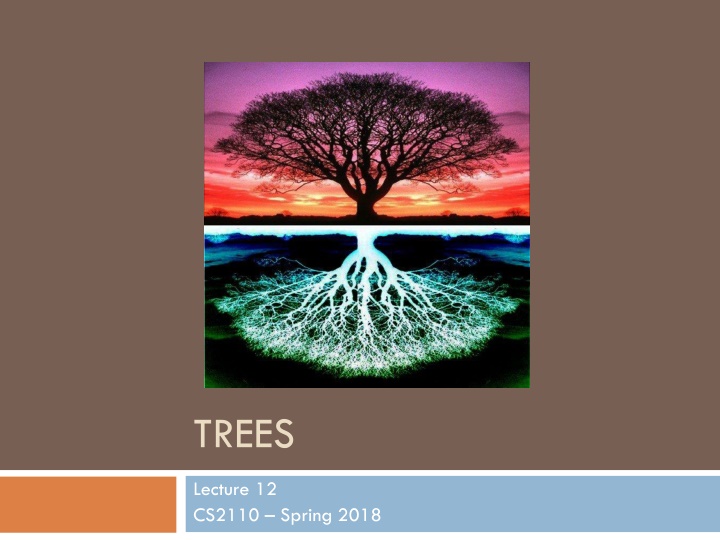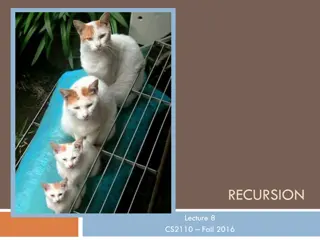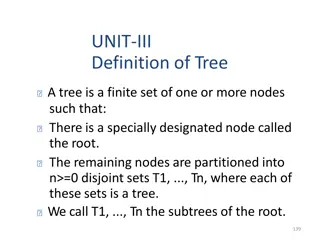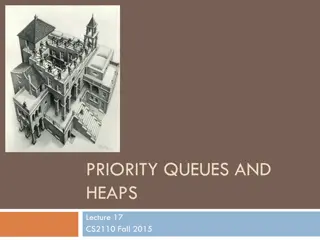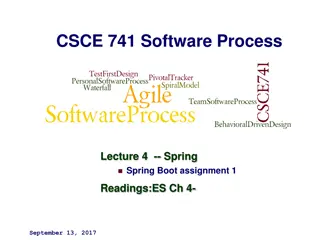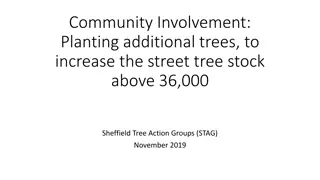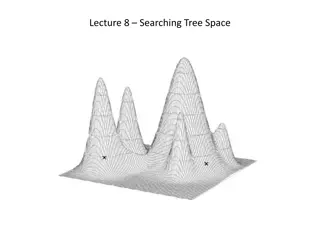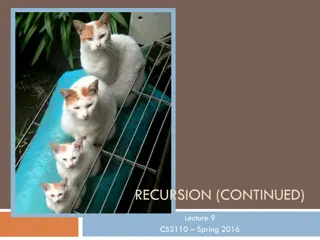Data Structures and Tree Overview in CS2110 Spring 2018
Covering important announcements, different ways of storing data with examples like arrays and linked lists, the problem of search, and an overview of trees including terminology like roots, leaves, ancestors, and descendants in CS2110 Spring 2018. Explore various data structures and learn about the tree structure with nodes, successors, and predecessors, distinguishing trees from non-trees. Dive into tree terminology, understanding roots, children, ancestors, and descendants in this comprehensive lecture series.
Uploaded on Apr 13, 2025 | 1 Views
Download Presentation

Please find below an Image/Link to download the presentation.
The content on the website is provided AS IS for your information and personal use only. It may not be sold, licensed, or shared on other websites without obtaining consent from the author.If you encounter any issues during the download, it is possible that the publisher has removed the file from their server.
You are allowed to download the files provided on this website for personal or commercial use, subject to the condition that they are used lawfully. All files are the property of their respective owners.
The content on the website is provided AS IS for your information and personal use only. It may not be sold, licensed, or shared on other websites without obtaining consent from the author.
E N D
Presentation Transcript
TREES Lecture 12 CS2110 Spring 2018
Important Announcements 2 A4 is out now and due two weeks from today. Have fun, and start early! There are slots available for lunch with the professors: http://signup.com/go/myeCehh link from Piazza Recitation 6: Iterator and Iterable Watch the tutorials! Quiz due on Monday (yes, that's the day before the prelim, sorry)
Data Structures 3 There are different ways of storing data, called data structures Each data structure has operations that it is good at and operations that it is bad at For any application, you want to choose a data structure that is good at the things you do often
Example Data Structures 4 Data Structure add(val x) lookup(int i) Array 2 1 3 0 ?(?) ?(1) Linked List 2 ?(1) ?(?) 1 3 0
Example Data Structures 6 Data Structure add(val x) lookup(int i) search(val x) Array 2 1 3 0 ?(?) ?(?) ?(1) Linked List 2 ?(1) ?(?) ?(?) 1 3 0
Tree 7 Singly linked list: 2 1 1 0 Node object pointer 0 int value 2 1 Today: trees! 4 1 1 0 1
Tree Overview 8 5 5 Tree: data structure with nodes, similar to linked list Each node may have zero or more successors (children) Each node has exactly one predecessor (parent) except the root, which has none All nodes are reachable from root 2 4 2 4 8 9 7 8 7 9 A tree Not a tree 5 5 4 6 7 8 8 A tree Not a tree
Tree Terminology 9 the root of the tree (no parents) M child of M G W child of M D J P B H N S the leaves of the tree (no children)
Tree Terminology 10 M G W ancestors of B D J P descendants of W B H N S
Tree Terminology 11 M subtree of M G W D J P B H N S
Tree Terminology 12 A node s depth is the length of the path to the root. A tree s (or subtree s) height is he length of the longest path from the root to a leaf. M Depth 1, height 2. G W D J P Depth 3, height 0. B H N S
Tree Terminology 13 Multiple trees: a forest. G W D J P B H N S
Class for general tree nodes class GTreeNode<T> { private T value; private List<GTreeNode<T>> children; //appropriate constructors, getters, //setters, etc. } 14 5 4 2 Parent contains a list of its children General tree 8 9 7 1 8 3 7
Binary Trees 16 A binary tree is a particularly important kind of tree where every node as at most two children. 5 5 4 2 4 2 In a binary tree, the two children are called the left and right children. 8 9 7 8 7 Not a binary tree (a general tree) Binary tree
Binary trees were in A1! 17 You have seen a binary tree in A1. A PhD object has one or two advisors. (Confusingly, the advisors are the children. ) David Gries Friedrich Bauer Georg Aumann Fritz Bopp Fritz Sauter Erwin Fues Heinrich Tietze Constantin Carathodory
Class for binary tree node 18 class TreeNode<T> { private T value; private TreeNode<T> left, right; Either might be null if the subtree is empty. /** Constructor: one-node tree with datum x */ public TreeNode (T v) { value= v; left= null; right= null;} /** Constr: Tree with root value x, left tree l, right tree r */ public TreeNode (T v, TreeNode<T> l, TreeNode<T> r) { value= v; left= l; right= r; } } more methods: getValue, setValue, getLeft, setLeft, etc.
A Tree is a Recursive Thing 20 A binary tree is either null or an object consisting of a value, a left binary tree, and a right binary tree.
Looking at trees recursively Binary tree 21 2 Right subtree (also a binary tree) 9 0 8 3 5 7 Left subtree, which is a binary tree too
Looking at trees recursively a binary tree
Looking at trees recursively value right subtree left subtree
A Recipe for Recursive Functions 25 Base case: If the input is easy, just solve the problem directly. Recursive case: Get a smaller part of the input (or several parts). Call the function on the smaller value(s). Use the recursive result to build a solution for the full input.
Recursive Functions on Binary Trees 26 Base case: empty tree (null) or, possibly, a leaf Recursive case: Call the function on each subtree. Use the recursive result to build a solution for the full input.
Comparing Data Structures 29 Data Structure add(val x) lookup(int i) search(val x) Array 2 1 3 0 ?(?) ?(?) ?(1) Linked List 2 ?(1) ?(?) ?(?) 1 3 0 2 Binary Tree ?(?) ?(1) ?(?) 3 1
Binary Search Tree (BST) 30 A binary search tree is a binary tree that is ordered and has no duplicate values. In other words, for every node: - All nodes in the left subtree have values that are less than the value in that node, and - All values in the right subtree are greater. 5 > 5 < 5 2 8 0 3 7 9 A BST is the key to making search way faster.
Building a BST 31 To insert a new item: Pretend to look for the item Put the new node in the place where you fall off the tree
Building a BST 32 january
Building a BST 33 january
Building a BST 34 january february
Building a BST 35 january february
Building a BST 36 january february
Building a BST 37 january march february
Building a BST 38 january february march
Building a BST 39 january april february march
Building a BST 40 january april february march
Building a BST 41 january february march april
Building a BST 42 january february march april
Building a BST 43 january february march april may june august september july october december november
Printing contents of BST 44 /** Print BST t in alpha order */ private static void print(TreeNode<T> t) { if (t== null) return; print(t.left); System.out.print(t.value); print(t.right); } Because of ordering rules for a BST, it s easy to print the items in alphabetical order Recursively print left subtree Print the node Recursively print right subtree
Binary Search Tree (BST) 46 5 2 8 0 3 7 9 Compare binary tree to binary search tree: boolean searchBT(n, v): if n==null, return false if n.v == v, return true return searchBST(n.left, v) || searchBST(n.right, v) boolean searchBST(n, v): if n==null, return false if n.v == v, return true if v < n.v return searchBST(n.left, v) else return searchBST(n.right, v) 2 recursive calls 1 recursive call
Comparing Data Structures 47 Data Structure add(val x) lookup(int i) search(val x) Array 2 1 3 0 ?(?) ?(?) ?(1) Linked List 2 ?(1) ?(?) ?(?) 1 3 0 1 Binary Tree ?(?) ?(1) ?(?) 3 2 2 BST ?(???? ) ?(???? ) ?(???? ) 3 1
Inserting in Alphabetical Order 48 april
Inserting in Alphabetical Order 49 april
Inserting in Alphabetical Order 50 april august
Inserting in Alphabetical Order 51 april august
Inserting in Alphabetical Order 52 april august december
Inserting in Alphabetical Order 53 april august december february january
Insertion Order Matters 54 A balanced binary tree is one where the two subtrees of any node are about the same size. Searching a binary search tree takes O(h) time, where h is the height of the tree. In a balanced binary search tree, this is O(log n). But if you insert data in sorted order, the tree becomes imbalanced, so searching is O(n).
Things to think about 55 What if we want to delete data from a BST? jan feb mar A BST works great as long as it s balanced. There are kinds of trees that can automatically keep themselves balanced as you insert things! apr jun may jul
